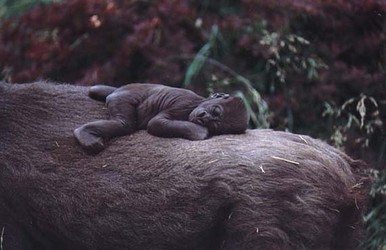When gorillas were first discovered by scientists, they were thought to be a kind of monkey. Then, Darwin introduced the idea that we are related to Gorillas. This caused some people to view them as grotesque, savage animals. Many refused to believe that we could be related to them. Some claimed that apes could be related only to black humans. Because their relation to humans could not be denied nor explained, apes became an odd target of prejudice. Now we know that gorillas are apes, not monkeys, and that all humans are equally related to them. All of the apes came from a common ancestor. We share 98% of our genes with gorillas. We even call ourselves apes.
- Kingdom: Animalia
- Phylum: Chordata
- Class: Mammalia
- Order: Primates
- Family: Hominidae
- Genus: Gorilla
- Species: gorilla (western lowland) & beringei (mountain)
Physical Characteristics
- Adult male mountain gorillas can weigh up to 484 pounds and females up to 215 pounds. Western lowland adult male gorillas weigh about 374 pounds; females about 158 pounds. Eastern lowland males are about 484 pounds; females about 176 pounds.
- Gorilla’s stomachs are larger than their chests. This is because of their enlarged intestines, which digest the fibrous vegetation they consume. Gorillas also have larger arms than legs. They use their upper body strength for bending and gathering foliage and for defense. They also primarily walk on four limbs.
- Gorillas have black to brownish-gray hair and dark skin. Males get silver hair on their backs and upper thighs at sexual maturity. This creates an optical illusion of increased size. Lowland gorillas have short, sparse hair and mountain gorillas have long, silky hair. They have no hair on their fingers, palms, soles, nose, lips, ears, and chest.
- Gorillas have 32 large, strong teeth for grinding vegetation. The males develop sharp canines as they mature.
- Most gorillas are omnivores and eat a variety of food including vegetation, fruit, and insects.
- The head of the gorilla has a bulging forehead that protects the eyes. The sagittal crest supports the large jaw muscles.
Lifestyle
- Gorillas primarily live in tropical rainforest habitats.
- They do not overexploit an area for food. They crop the vegetation in a manner that allows for quick replenishment to occur.
- They are non-territorial and live in groups of 1-4 adult males, several adult females, and young. Adult females do not bond and will compete for the attention of the silverback. When females reach adolescence, they transfer to another troop to reproduce. The first troop they reproduce in usually becomes their family. Adolescent males also usually leave the troop they were born in due to lack of breeding opportunities.2
- Leopards and crocodiles may prey upon gorillas, but humans are their greatest threat.
- Many diseases that infect humans may also infect gorillas. Hepatitis A, poliovirus, tapeworm, and tuberculosis are some of the diseases gorillas can contract from their environment. In 2002 the Ebola virus caused the death of many gorilla groups.3
Gorillas develop in basically the same way as humans before they are born. Their life stages are egg, zygote, embryo, fetus, and adult. The fetus stays in the womb for about 8.5 months. Females become sexually mature adults at about 7 years old, but don’t usually reproduce until they are at least 10. Males mature later and aren’t dominant enough to reproduce before 15 to 20 years of age.4
Gorillas are triploblastic animals. This means that their embryos have three cell layers: the endoderm (inner), the mesoderm (middle), and the ectoderm (outer). They have a coelem, which is a body cavity that surrounds the internal organs and protects them from damage. Gorillas are bilaterally symmetrical, meaning that their left and right sides are mirror images of each other.








 Go to quick links
Go to quick search
Go to navigation for this section of the ToL site
Go to detailed links for the ToL site
Go to quick links
Go to quick search
Go to navigation for this section of the ToL site
Go to detailed links for the ToL site